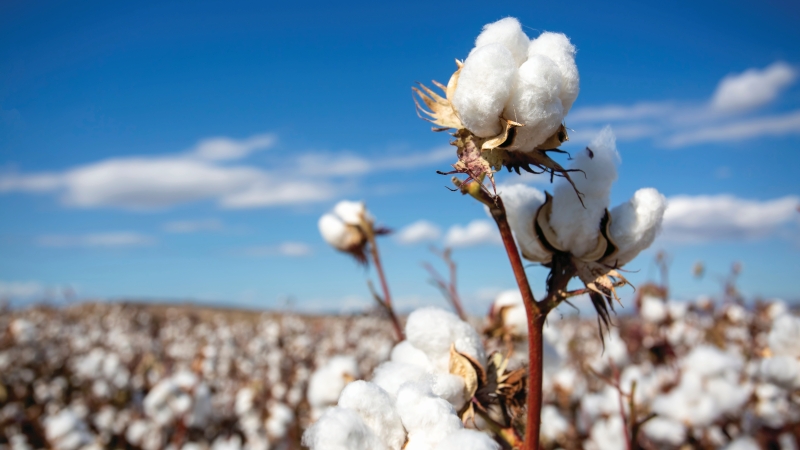Was USDA Right? U.S. Crop Looking Bigger.
The anticipated big U.S. crop took cotton prices lower on the week, as reports from both India and China suggested those crops were progressing well.
With production in the world’s leading exporting countries increasing, textile mills will find a very adequate supply of cotton during the 2017-18 marketing season. Granted, there will be a shortage of high grades prior to December, and that will work to support a strong cash basis going into the November peak harvest period. However, the “barn bursting” high quality yields currently being harvested in South Texas have somewhat alleviated this.
This general scenario assumes Mother Nature will allow for the maturity and harvest of near record yields in much of the U.S., as well as for the much improved Indian crop. Too, with much of the Northern Hemisphere crop late this season, there will be more than the usual quality concerns. These factors will work to keep December futures trading in the current 65-69 cent trading range into early September.
Note however, as I continue to enjoy small tastings of crow, the U.S. crop – with nothing more than just a good fall – can climb as much as one million bales higher than the surprise August estimate of 20.5 million bales. The actual harvest of 20 million bales plus will make it all but impossible for December to scale the 70 cent barrier.
The U.S. crop is giving clear signals that it is getting bigger and bigger. A number of us commented last week that the August crop report would show the largest crop estimate of the year, but that scenario does not seem to be the case. The market adage “big crops get bigger” may well be in play this year (that saying is more of an “old wives tale” than adage).
Delta and Southeast yields are on the cusp of new regional records. Texas could yet climb to a record yield. Of course, the greenhouse conditions of California will provide excellent yields. However, it should be noted that the California crop is late and behind schedule. However, there is a “world of time” remaining before this crop is harvested. In reality, there are some 8-10 weeks of good weather that must now follow if such a monster crop is to be harvested.
However, Mother Nature does not have a favorable history of offering the cotton grower such a weather pattern. The crop will need another rain event in August and again in September, followed by a near totally dry and warm October. It has happened before in record yield years and could happen again. The Texas Plains will have to successfully fight off any early frost or even abnormally cool night time temperatures. It is not likely, but the fruit is on the plant. Thus, the crop estimate cannot be discounted unless one chooses to know what the weather will actually be.
Growers have had three excellent opportunities to price portions of their anticipated production between 73 and almost 76 cents and between 71 and 73 cents. Those that did are very pleased. Those that did not most likely will find their best alternative will be to fix the basis at harvest and take that as the final price, or to fix the basis at harvest and purchase a 2-3 cent out-of-the-money call option. Those that purchase the call option – the recommended marketing alternative – are hoping for a July futures price increase which most likely would come from some November-January weather event that significantly reduces either the quantity or quality of the 2017 harvest.
Yet, the market could also receive a boost should USDA adjust its world supply demand data base to conform to the call of most analysts, world merchandising firms and cotton producing countries. This places USDA in the center of the bulls eye – a most uncomfortable position, and one they will work overtime to avoid. Yet, historically, such changes are made from time to time and have caused major market moves. The market is more familiar with such changes associated with China. But the cotton world has changed, and more and more are “expecting” changes in the Indian numbers. Yet, attempting to guess what USDA might do is much akin to guessing what the market will do, and rightfully so.
World cotton trade will be more competitive in 2017-18, owing to the increased world crop. However, the success of domestic sales out of the Chinese National Reserve has kept Chinese mills in the market for more imports than projected. This trend is expected to continue, as the Reserve inventory will likely drop to just above 25-26 million bales by the end of this year’s sale at the end of September.
Just as last year, the Reserve will only purchase high quality new crop cotton. Thus, mid to lower quality cottons will compete in the cash market. As Chinese mills purchase these lesser qualities, the need for high quality imports for blending purposes will be enhanced.
The result will be a continued strong demand for Australian, Brazilian, and U.S. growths. While other growths will benefit – Syrian, African, Central Asian and Indian – the primary demand will be from the former countries. Too, since the U.S will have the largest amount of exportable supplies coupled with lack of carry in the market, U.S. basis export offers will tend to be the most competitive available, and U.S. exports will hold between 14.5 and 15.5 million bales, assuming the U.S. harvest is as large as currently forecast.
Thus, until some weather event says otherwise, the market will assume such a crop will be harvested and trade accordingly, between 65 and 69 cents with a bias to move lower.
Near term and long term, including to the 2018 crop, growers should be sellers on any move to 70 cents. Mills should be extremely aggressive buyers (price fixing) on any move to 66 cents and below.
Give a gift of cotton today.








